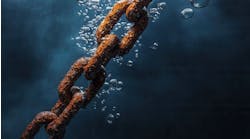Integrity management and life extension of flexible pipe
Chris Saunders, Tim O’Sullivan, MCS
This technical presentation updates the 2002 UK Offshore Operators Association (UKOOA) guidance note on monitoring and assuring the integrity of un-bonded flexible pipe (FP) in the North Sea area, and demonstrates lessons learned and key points for consideration developed since that time, using examples from the field.
The authors point out that the updated (to 2007) guidance note on FP use includes assets operating in the North Sea area, but also includes those at work in Brazil, Australasia, the Gulf of Mexico, and West Africa.
The updated data reveal that more than 80% of FP damage occurs in the first three years of operation. Furthermore, 35% of such cases occur in “Year 0,” during factory acceptance testing, installation or commissioning; i.e. before production has even started.
A significant data set developed for the update identifies and compares the main causes of FP damage in both 2002 and 2007. A few notable differences are indicated.
- The percentage of “internal sheath pull-out” has fallen. This is due to an historical failure mode associated with early PVDF design structures, which was eventually designed out
- The total of “aged internal pressure sheath” incidents also fell, mostly due to increased industry knowledge on recommended operating restriction for polymers such as PA-11
- A marked increase in the number of occurrences of “external sheath damage” can be explained by an increase in vacuum testing and other monitoring/inspection techniques for the annulus, which have made it possible to identify external sheath damage. Also, a significant amount of external sheath damage occurs during installation.
General visual inspection (GVI) of FP until recently has been considered a key element in maintaining system integrity. However, operators are increasingly questioning the value of frequent GVI, driven partly by a current tight market for dive support vessels and ROVs. But the disadvantages of such frequent inspections clearly outweigh the advantages, and these are compared in detail in the presentation. And while GVI is still required both by operators and regulators, fewer visual inspections can be augmented today by alternative annulus inspection methods such as vacuum and pressure build-up testing, gas sampling, and online monitoring. By using such techniques in conjunction with an integrated integrity strategy and risk assessment, say the authors, it is possible to justify the use of a more focused GVI for FP systems.
Also addressed in the update is analysis of the operating history of FP as a means of extending the pipe’s useful life. This would include an assessment of fatigue, polymer aging, and anomalies identified by GVI. The authors refer to a recently completed joint industry project called RealLife, which studied the complicated area of FP fatigue life and came up with methodologies that are considered significant advances in calculating FP fatigue damage.
Also discussed is FP re-use and re-deployment. A quality integrity management strategy using the correct mix of inspection and assessment tools and procedures, allows operators to gauge the potential for redeployment of FP. Also, it is necessary to consider carefully the additional requirements – and costs – associated with recovery, storage, testing and re-installation.
The authors note that given that about three times more information is available on FP today than in 2002, and they recommend that the industry consider updating the guidance studies to reflect current industry thinking. This, they observe, should include a worldwide update on types of failure and percentage occurrences and challenge the inspection strategies previously recommended, along with identifying emerging inspection and monitoring techniques.




